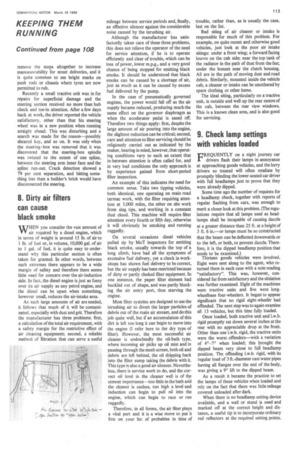9. Check lamp settings with vehicles loaded
Page 115

If you've noticed an error in this article please click here to report it so we can fix it.
uREQUENTLY on a night journey car
drivers flash their lamps in annoyance at approaching goods vehicles, and the lorry drivers so treated will often retaliate by promptly blinding the lower-seated car driver with full headlamps just to prove that they were already dipped.
Some time ago the number of requests for a headlamp check, together with reports of regular flashing from cars, was enough to merit a closer look at this problem. (The regulations require that all lamps used as headlamps shall be incapable of causing dazzle at a greater distance than 25 ft. at a height of 3 ft. 6 in.—or lamps must be so constructed that the beam can be deflected downwards or to the left, or both, to prevent dazzle. Therefore, it is the dipped headlamp position that needs to be examined) Thirteen goods vehicles were involved. Eight were sent along to the agent, who returned them in each case with a note reading "satisfactory". This was, however, considered far from satisfactory and the situation was further examined. Eight of the machines were tractive units and five were longwheelbase four-wheelers. It began to appear significant that no rigid eight-wheeler had offended. The next step was to again examine all 13 vehicles, but this time fully loaded.
Once loaded, both tractive unit and 1.w.b. rigid promptly sat down several inches at the rear with no appreciable drop at the front. Other than one 1.w.b. rigid, the tractive units were the worst offenders—with a variation of 4°-7° when loaded; this brought the dipped beam very close to full headlamp position. The offending 1.w.b. rigid, with its regular load of 3 ft.-diameter cast water pipes having all flanges over the end of the body, was giving a 9° lift to the dipped beam.
As a result it became the practice to set the lamps of these vehicles when loaded and rely on the fact that there was little mileage covered unloaded after dark.
When there is no headlamp setting device available, and a wall or stand is used and marked off at the correct height and distance, a useful tip is to incorporate ordinary red reflectors at the required setting points.




































































































































































